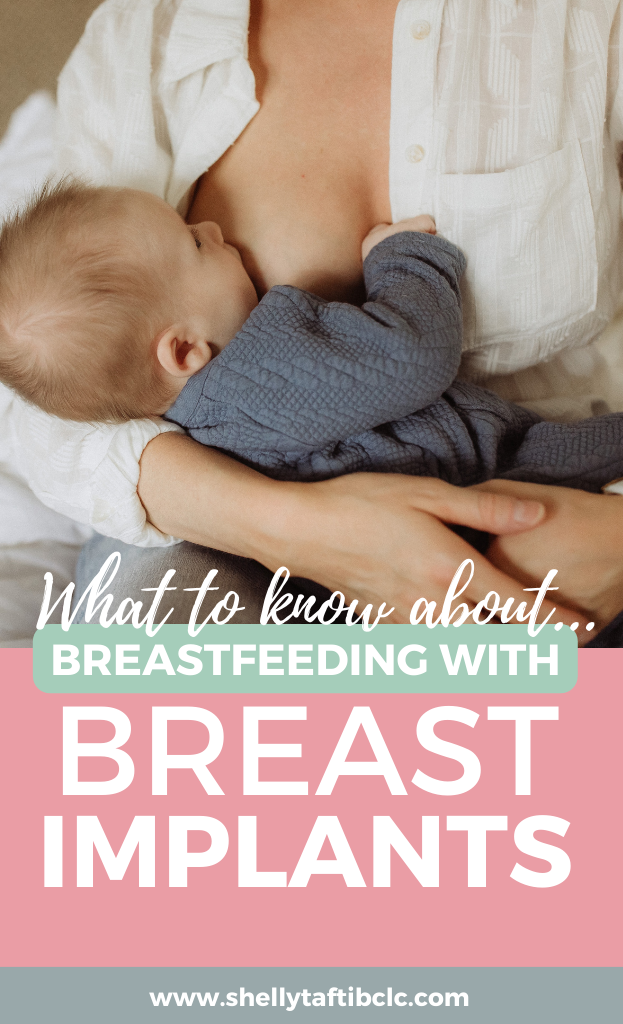Breastfeeding with Breast Implants: What You Need to Know

Do you want to breastfeed your baby? Worried about whether your breast implants will effect breastfeeding? Are you wondering if you can be successful at breastfeeding? Let’s talk about it!
What are breast implants?
Breast implants are medical devices that are used to enhance the size and shape of a persons breasts. They are typically made of silicone or saline and are inserted into the breast tissue through incisions made in the breast or armpit. There are different types of implants available, including round and teardrop-shaped, and they come in a variety of sizes and textures. Breast augmentation surgery is the most common cosmetic surgery procedure in the United States.
Breast implants are usually inserted during a surgical procedure known as breast augmentation. The procedure is typically performed under general anesthesia and can take anywhere from one to three hours. During the surgery, the surgeon will make an incision either in the crease under the breast, around the areola, or in the armpit. The surgeon will then create a pocket either directly behind the breast tissue or under the chest muscle. The implant is then inserted into the pocket and positioned to achieve the desired shape and size. The incision is then closed with sutures, and bandages are applied to the incision site.
How Do Breast Implants Impact Breastfeeding?
Sometimes having breast implants doesn’t impact breastfeeding at all, and sometimes it can cause a lot of problems. There are a number of factors that come into play when it comes to how successful you can be breastfeeding with implants:
- Where was the implant inserted? Was it directly behind the breast tissue or under the chest muscle? If your implants were placed under the chest muscle, the risk of having implants impacting your supply or breastfeeding, in general, is lower.
- Where was the incision made? If the incision was made in the breast, for example around the areola, rather than the armpit area, that can make breastfeeding more difficulty. For example, if your incision goes around your areola or nipple at all, some of the milk ducts could have been severed, or some of the nerves that involve feeling sensations in your nipple. If your ducts are severed and you can’t feel your baby suckling at the breast much, then that can result in lowered milk supply.
- Incisions can make engorgement much harder, especially if your implants are directly behind the breast tissue. As your milk comes in, and blood and other fluid flow into your breast, this can create a lot of swelling and firmness around the implant itself, which can be very uncomfortable for the nursing parents.
Those are the three main reasons why breast implants may make breastfeeding difficult, but we also have to talk about one more situation: why you got implants to begin with.
Hypoplasia and Low Milk Supply
It’s no secret that we are all different, and no two pair of breasts look alike. It’s normal for breasts to be asymmetrical or different in shape and size. And for most parents, this is just a normal variation that doesn’t impact their breastfeeding in any way.
However there is a condition called IGT, or insufficient glandular tissue. Some people also refer to IGT as hypoplasia.
Severe cases of IGT can sometimes result in breasts that are very different in shape and size. Some parents who have this severe form of IGT choose to get implants to make their breasts look more similar or to make them the same size.
However, IGT in itself causes low milk supply. So when I am working with a parent who has had augmentation, I will ask questions about what their breasts look and felt like before they got their implants.
Because sometimes its not the implants that are causing the low milk supply, but the reason why the parents got the implants – the IGT.
You can learn more about IGT and how it impacts breastfeeding here.
Okay, So I Have Implants and Want to Breastfeed – What Do I Do?
My first recommendation is to work prenatally with an IBCLC. Working with an IBCLC before your baby arrives means you have more time to prepare and learn about things you can do to maximize your supply and reduce the risk of the severe engorgement that implants can sometimes cause.
Talk to your OBGYN or your IBCLC about harvesting colostrum at the end of your pregnancy. Practicing hand expression will help you get that new skill down pat before baby arrives, and will help with your milk supply.
When baby does arrive, monitor your baby’s weight gain closely, especially after the first couple of weeks, when baby’s feedings amounts increase. We want to watch for any signs that baby is not getting enough at the breast, and support baby’s nutrition as needed with supplementation.
Remember, having breast implants can make breastfeeding more difficult, but that doesn’t mean it will for you! Many parents with implants breastfeed just fine with no issues.
Did you breastfeed with breast implants? Share your story in the comments!
